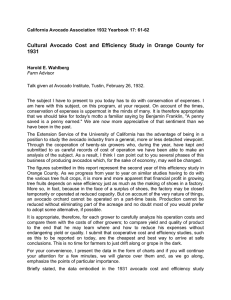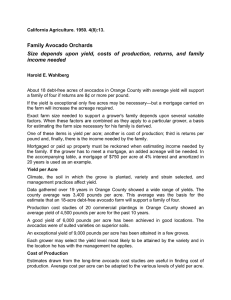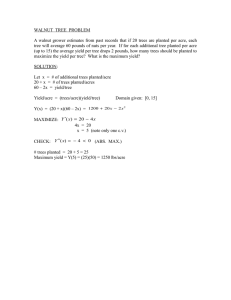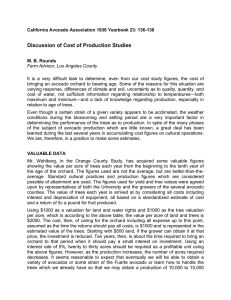California Avocado Society 1942 Yearbook 26: 86-96
advertisement
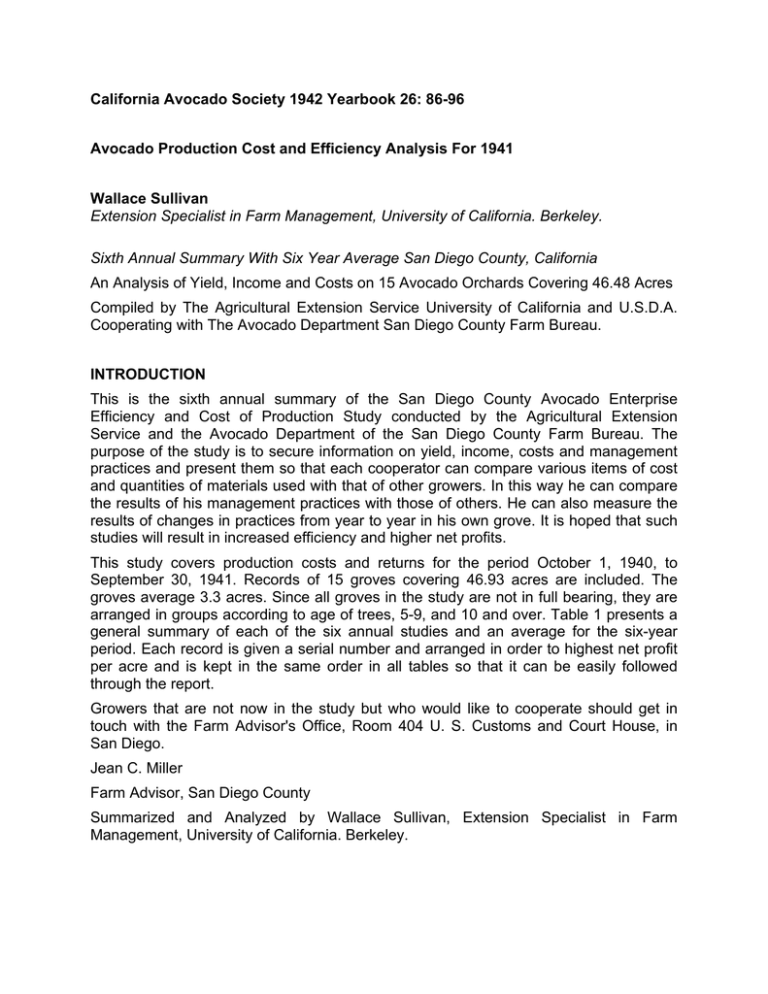
California Avocado Society 1942 Yearbook 26: 86-96 Avocado Production Cost and Efficiency Analysis For 1941 Wallace Sullivan Extension Specialist in Farm Management, University of California. Berkeley. Sixth Annual Summary With Six Year Average San Diego County, California An Analysis of Yield, Income and Costs on 15 Avocado Orchards Covering 46.48 Acres Compiled by The Agricultural Extension Service University of California and U.S.D.A. Cooperating with The Avocado Department San Diego County Farm Bureau. INTRODUCTION This is the sixth annual summary of the San Diego County Avocado Enterprise Efficiency and Cost of Production Study conducted by the Agricultural Extension Service and the Avocado Department of the San Diego County Farm Bureau. The purpose of the study is to secure information on yield, income, costs and management practices and present them so that each cooperator can compare various items of cost and quantities of materials used with that of other growers. In this way he can compare the results of his management practices with those of others. He can also measure the results of changes in practices from year to year in his own grove. It is hoped that such studies will result in increased efficiency and higher net profits. This study covers production costs and returns for the period October 1, 1940, to September 30, 1941. Records of 15 groves covering 46.93 acres are included. The groves average 3.3 acres. Since all groves in the study are not in full bearing, they are arranged in groups according to age of trees, 5-9, and 10 and over. Table 1 presents a general summary of each of the six annual studies and an average for the six-year period. Each record is given a serial number and arranged in order to highest net profit per acre and is kept in the same order in all tables so that it can be easily followed through the report. Growers that are not now in the study but who would like to cooperate should get in touch with the Farm Advisor's Office, Room 404 U. S. Customs and Court House, in San Diego. Jean C. Miller Farm Advisor, San Diego County Summarized and Analyzed by Wallace Sullivan, Extension Specialist in Farm Management, University of California. Berkeley. DEFINITION OF TERMS USED IN STUDY Yield in pounds per acre times average price per pound for fruit produced equals Total Income per acre. Income per acre less costs per acre equals net income or profit per acre. Costs, unfortunately, are not always computed in the same way or considered to cover the same things. Some individuals consider their own labor, depreciation on facilities, or interest on their investment. Such a figure is not shown in this report since to obtain significant operation costs, the value of the operator's actual labor had to be included along with hired labor. In this study labor costs, which are considered as cash costs, include the value of the operator's actual labor, the cost of hired labor, the cost or value of horse, truck, and tractor work, and the cost of contract work. The nearest earning figure for the grower who wishes to compare his net cash income would be the Income Above Cash Costs including as cash costs, labor, material, and cash overhead costs. It may be computed by subtracting labor, material, and cash overhead costs from income, or by adding depreciation to capital and management income. The best net earning figure, from the individual grower's standpoint, is the Capital and Management Income. It is the amount by which income exceeds all costs except interest on investment. It is the difference between total income and "Cash Costs and Depreciation." It is the amount available to reimburse management and to pay for invested capital. It is the amount the grower receives over and above wages for actual work included in labor costs, provided he must pay no interest on borrowed capital. Interest on actual indebtedness is not compiled or recognized in this study, interest on the entire investment being assumed to cover interest on borrowed money and the grower's net investment or equity. No managerial salary for the grower is included as a cost, although it is considered in dividing capital and management income. In obtaining cost of production from an economic standpoint, interest on the investment is widely recognized as an element of cost. To obtain such a total cost, the interest shown is added to cash and depreciation costs. Management Income or Net Profit is the amount by which income exceeds all costs of production, including interest on investment as a cost. It is the amount available to reimburse the operator for his management. If his management and luck have been good, he will be rewarded by such an income, but where income is too small to cover costs, a loss or deficit will occur, which in this report is indicated by a minus sign (-) preceding the amount. Table 1 presents a general summary of the avocado cost of production studies made in San Diego County during the six-year period, 1936-1941, and an average of all records for that period. The records in this study are from orchards with trees five years of age and over. The average age of all trees during this period was 9 years. Many of the trees in these orchards have been topworked or replaced so that they have not had a fair chance to demonstrate their full productive capacity. This study, therefore, does not represent the full productive capacity of mature groves. The average yield per acre during this period has varied from a high of 8,289 pounds to a low of 2,525 pounds, with an average for the six-year period of 4,731. The average price received per hundredweight has varied from $4.72 in 1939 to $9.59 in 1936, with an average of $6.33 for the six-year period. Total costs per acre as averaged for the six-year period are $245.57, while the total income has averaged $299.31, making an average net profit per acre of $53.74. Without considering interest on investment as a cost, the capital and management income per acre has averaged $153.31. A Standard of Labor, Material, and other Costs of Producing Avocados in Southern California Orchards about 15 years of age, with an Average Annual Yield of 6000 Ibs. per acre. This table is a computed standard of costs for a well managed mature avocado orchard with most of the work done by the owner. Investment, depreciation and rates for truck and tractor are based upon a 20-acre farm unit. Labor costs per acre are computed at the following rates per hour: man labor, $.30, 12drawbar horsepower tractor $1.30, 1½-ton truck, $1.50. Costs per hundredweight shown above are based on a yield of 6000 pounds. Yields some years would be double this and some years they might fall as low as 2000 Ibs. Aside from harvesting, which may be computed at $.60 per hundredweight, costs per acre will not vary much for different yields. To obtain cost of production for any other yield, adjust the total cost per acre for the difference in harvesting cost and then divide by the yield. With the above yield total cost is $4.24 per hundredweight, with a yield of 2500 pounds. Cost per hundredweight would be $9.40.
